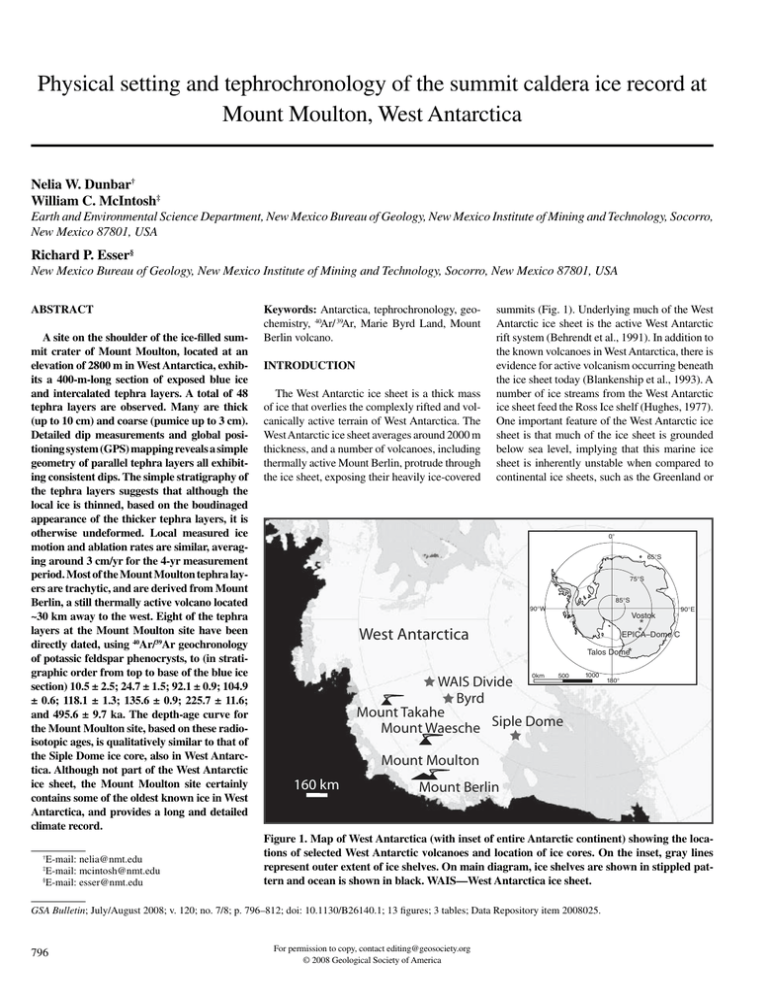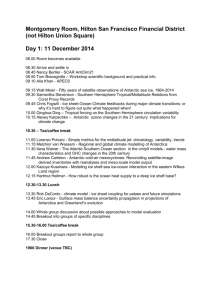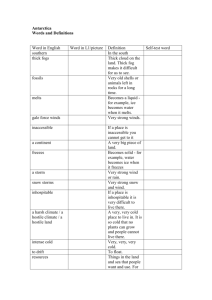Physical setting and tephrochronology of the summit caldera ice record... Mount Moulton, West Antarctica
advertisement

Physical setting and tephrochronology of the summit caldera ice record at Mount Moulton, West Antarctica Nelia W. Dunbar† William C. McIntosh‡ Earth and Environmental Science Department, New Mexico Bureau of Geology, New Mexico Institute of Mining and Technology, Socorro, New Mexico 87801, USA Richard P. Esser§ New Mexico Bureau of Geology, New Mexico Institute of Mining and Technology, Socorro, New Mexico 87801, USA ABSTRACT A site on the shoulder of the ice-filled summit crater of Mount Moulton, located at an elevation of 2800 m in West Antarctica, exhibits a 400-m-long section of exposed blue ice and intercalated tephra layers. A total of 48 tephra layers are observed. Many are thick (up to 10 cm) and coarse (pumice up to 3 cm). Detailed dip measurements and global positioning system (GPS) mapping reveals a simple geometry of parallel tephra layers all exhibiting consistent dips. The simple stratigraphy of the tephra layers suggests that although the local ice is thinned, based on the boudinaged appearance of the thicker tephra layers, it is otherwise undeformed. Local measured ice motion and ablation rates are similar, averaging around 3 cm/yr for the 4-yr measurement period. Most of the Mount Moulton tephra layers are trachytic, and are derived from Mount Berlin, a still thermally active volcano located ~30 km away to the west. Eight of the tephra layers at the Mount Moulton site have been directly dated, using 40Ar/39Ar geochronology of potassic feldspar phenocrysts, to (in stratigraphic order from top to base of the blue ice section) 10.5 ± 2.5; 24.7 ± 1.5; 92.1 ± 0.9; 104.9 ± 0.6; 118.1 ± 1.3; 135.6 ± 0.9; 225.7 ± 11.6; and 495.6 ± 9.7 ka. The depth-age curve for the Mount Moulton site, based on these radioisotopic ages, is qualitatively similar to that of the Siple Dome ice core, also in West Antarctica. Although not part of the West Antarctic ice sheet, the Mount Moulton site certainly contains some of the oldest known ice in West Antarctica, and provides a long and detailed climate record. † E-mail: nelia@nmt.edu E-mail: mcintosh@nmt.edu E-mail: esser@nmt.edu ‡ § Keywords: Antarctica, tephrochronology, geochemistry, 40Ar/ 39Ar, Marie Byrd Land, Mount Berlin volcano. INTRODUCTION The West Antarctic ice sheet is a thick mass of ice that overlies the complexly rifted and volcanically active terrain of West Antarctica. The West Antarctic ice sheet averages around 2000 m thickness, and a number of volcanoes, including thermally active Mount Berlin, protrude through the ice sheet, exposing their heavily ice-covered summits (Fig. 1). Underlying much of the West Antarctic ice sheet is the active West Antarctic rift system (Behrendt et al., 1991). In addition to the known volcanoes in West Antarctica, there is evidence for active volcanism occurring beneath the ice sheet today (Blankenship et al., 1993). A number of ice streams from the West Antarctic ice sheet feed the Ross Ice shelf (Hughes, 1977). One important feature of the West Antarctic ice sheet is that much of the ice sheet is grounded below sea level, implying that this marine ice sheet is inherently unstable when compared to continental ice sheets, such as the Greenland or 0° 65°S 75°S 75°S 85°S 90°W Vostok West Antarctica Talos Dome* 0km 500 WAIS Divide Byrd Mount Takahe Mount Waesche Siple Dome 1000 180° Mount Moulton 160 km Mount Berlin Figure 1. Map of West Antarctica (with inset of entire Antarctic continent) showing the locations of selected West Antarctic volcanoes and location of ice cores. On the inset, gray lines represent outer extent of ice shelves. On main diagram, ice shelves are shown in stippled pattern and ocean is shown in black. WAIS—West Antarctica ice sheet. GSA Bulletin; July/August 2008; v. 120; no. 7/8; p. 796–812; doi: 10.1130/B26140.1; 13 figures; 3 tables; Data Repository item 2008025. 796 90°E * * EPICA–Dome C For permission to copy, contact editing@geosociety.org © 2008 Geological Society of America





